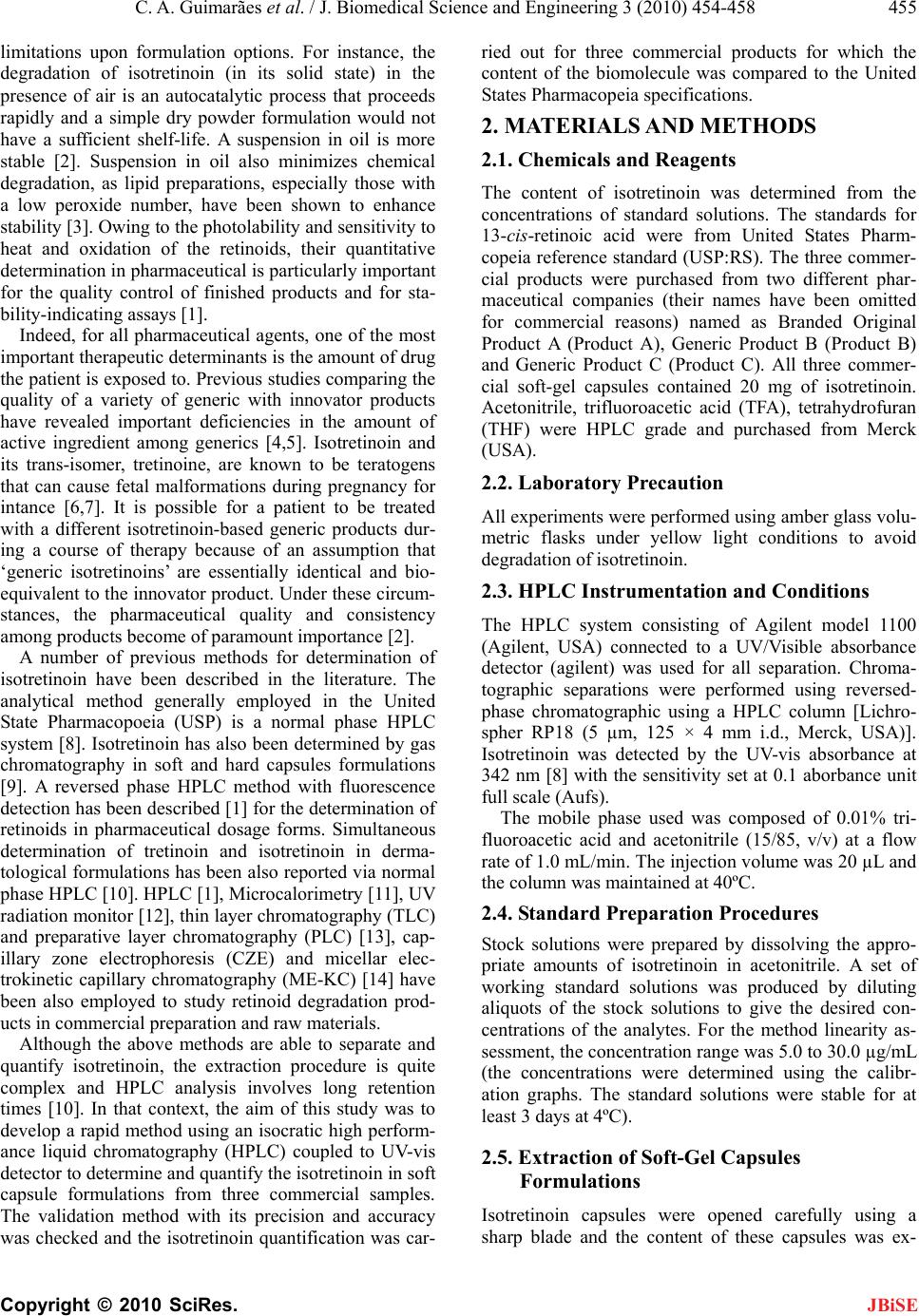
C. A. Guimarães et al. / J. Biomedical Science and Engineering 3 (2010) 454-458 455
Copyright © 2010 SciRes. JBiSE
limitations upon formulation options. For instance, the
degradation of isotretinoin (in its solid state) in the
presence of air is an autocatalytic process that proceeds
rapidly and a simple dry powder formulation would not
have a sufficient shelf-life. A suspension in oil is more
stable [2]. Suspension in oil also minimizes chemical
degradation, as lipid preparations, especially those with
a low peroxide number, have been shown to enhance
stability [3]. Owing to the photolability and sensitivity to
heat and oxidation of the retinoids, their quantitative
determination in pharmaceutical is particularly important
for the quality control of finished products and for sta-
bility-indicating assays [1].
Indeed, for all pharmaceutical agents, one of the most
important therapeutic determinants is the amount of drug
the patient is exposed to. Previous studies comparing the
quality of a variety of generic with innovator products
have revealed important deficiencies in the amount of
active ingredient among generics [4,5]. Isotretinoin and
its trans-isomer, tretinoine, are known to be teratogens
that can cause fetal malformations during pregnancy for
intance [6,7]. It is possible for a patient to be treated
with a different isotretinoin-based generic products dur-
ing a course of therapy because of an assumption that
‘generic isotretinoins’ are essentially identical and bio-
equivalent to the innovator product. Under these circum-
stances, the pharmaceutical quality and consistency
among products become of paramount importance [2].
A number of previous methods for determination of
isotretinoin have been described in the literature. The
analytical method generally employed in the United
State Pharmacopoeia (USP) is a normal phase HPLC
system [8]. Isotretinoin has also been determined by gas
chromatography in soft and hard capsules formulations
[9]. A reversed phase HPLC method with fluorescence
detection has been described [1] for the determination of
retinoids in pharmaceutical dosage forms. Simultaneous
determination of tretinoin and isotretinoin in derma-
tological formulations has been also reported via normal
phase HPLC [10]. HPLC [1], Microcalorimetry [11], UV
radiation monitor [12], thin layer chromatography (TLC)
and preparative layer chromatography (PLC) [13], cap-
illary zone electrophoresis (CZE) and micellar elec-
trokinetic capillary chromatography (ME-KC) [14] have
been also employed to study retinoid degradation prod-
ucts in commercial preparation and raw materials.
Although the above methods are able to separate and
quantify isotretinoin, the extraction procedure is quite
complex and HPLC analysis involves long retention
times [10]. In that context, the aim of this study was to
develop a rapid method using an isocratic high perform-
ance liquid chromatography (HPLC) coupled to UV-vis
detector to determine and quantify the isotretinoin in soft
capsule formulations from three commercial samples.
The validation method with its precision and accuracy
was checked and the isotretinoin quantification was car-
ried out for three commercial products for which the
content of the biomolecule was compared to the United
States Pharmacopeia specifications.
2. MATERIALS AND METHODS
2.1. Chemicals and Reagents
The content of isotretinoin was determined from the
concentrations of standard solutions. The standards for
13-cis-retinoic acid were from United States Pharm-
copeia reference standard (USP:RS). The three commer-
cial products were purchased from two different phar-
maceutical companies (their names have been omitted
for commercial reasons) named as Branded Original
Product A (Product A), Generic Product B (Product B)
and Generic Product C (Product C). All three commer-
cial soft-gel capsules contained 20 mg of isotretinoin.
Acetonitrile, trifluoroacetic acid (TFA), tetrahydrofuran
(THF) were HPLC grade and purchased from Merck
(USA).
2.2. Laboratory Precaution
All experiments were performed using amber glass volu-
metric flasks under yellow light conditions to avoid
degradation of isotretinoin.
2.3. HPLC Instrumentation and Conditions
The HPLC system consisting of Agilent model 1100
(Agilent, USA) connected to a UV/Visible absorbance
detector (agilent) was used for all separation. Chroma-
tographic separations were performed using reversed-
phase chromatographic using a HPLC column [Lichro-
spher RP18 (5 µm, 125 × 4 mm i.d., Merck, USA)].
Isotretinoin was detected by the UV-vis absorbance at
342 nm [8] with the sensitivity set at 0.1 aborbance unit
full scale (Aufs).
The mobile phase used was composed of 0.01% tri-
fluoroacetic acid and acetonitrile (15/85, v/v) at a flow
rate of 1.0 mL/min. The injection volume was 20 µL and
the column was maintained at 40ºC.
2.4. Standard Preparation Procedures
Stock solutions were prepared by dissolving the appro-
priate amounts of isotretinoin in acetonitrile. A set of
working standard solutions was produced by diluting
aliquots of the stock solutions to give the desired con-
centrations of the analytes. For the method linearity as-
sessment, the concentration range was 5.0 to 30.0 µg/mL
(the concentrations were determined using the calibr-
ation graphs. The standard solutions were stable for at
least 3 days at 4ºC).
2.5. Extraction of Soft-Gel Capsules
Formulations
Isotretinoin capsules were opened carefully using a
sharp blade and the content of these capsules was ex-